A History of the County of Hampshire: Volume 4. Originally published by Victoria County History, London, 1911.
This free content was digitised by double rekeying. All rights reserved.
'Parishes: Rockbourne', in A History of the County of Hampshire: Volume 4, ed. William Page (London, 1911), British History Online https://prod.british-history.ac.uk/vch/hants/vol4/pp581-586 [accessed 23 April 2025].
'Parishes: Rockbourne', in A History of the County of Hampshire: Volume 4. Edited by William Page (London, 1911), British History Online, accessed April 23, 2025, https://prod.british-history.ac.uk/vch/hants/vol4/pp581-586.
"Parishes: Rockbourne". A History of the County of Hampshire: Volume 4. Ed. William Page (London, 1911), British History Online. Web. 23 April 2025. https://prod.british-history.ac.uk/vch/hants/vol4/pp581-586.
In this section
ROCKBOURNE
Rochesburna (xi cent.); Rechesburna, Rochesburna (xii cent.); Rokeburn (xiii cent.); Rogborne (xvii cent.). Rockbourne contains about 3,923½ acres, of which 2,029 acres are arable land, 1,039½ acres permanent grass and 302¼ acres woods and plantations. (fn. 1) Rockbourne Down, in the north-west of the parish, and Knoll Down, which extends over the borders of Damerham, are in some places over 300 ft. high. The lowest part of the parish is along the banks of the little stream known as Sweatfords Water, which rises in Rockbourne Down and flows straight through the village by the side of the main street. The soil is sand, clay, gravel and chalk on a subsoil of chalk.
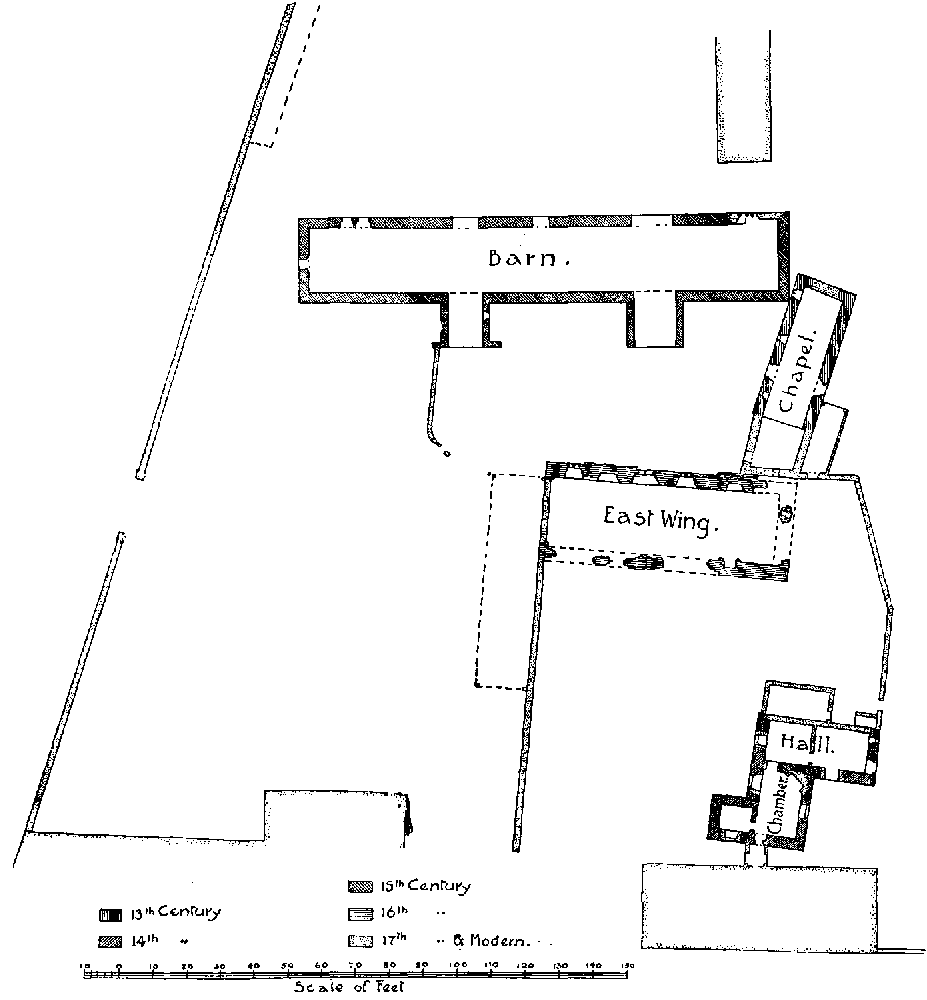
Plan of Manorial Buildings at Rockbourne
The village consists chiefly of one street almost half a mile long. The church is in the north-east of the main street Close to the church, adjoining the north side of the churchyard, is a very interesting group of buildings, consisting of a small L-shaped 14th-century house, now used as part of a modern farm-house, the remains of a large Elizabethan or Jacobean house a short distance to the east, a 13th-century chapel near its south-east angle, and a large 15th-century barn running northward from the chapel. The barn has two large waggon-porches, and at the north end has been divided into two stories for use as living rooms; the chapel is now used as a barn, and its most interesting feature is a north doorway with a cinquefoiled head. The buildings are doubtless manorial, the story of the existence of a leper hospital on the site being quite unfounded. (fn. 2) South of the village is West Park, the property of Sir Eyre Coote, which extends into South Damerham parish.
The commons in the parish were inclosed in 1802. (fn. 3) A hoard of coins was found in an urn at Brookheath about 1893. (fn. 4)
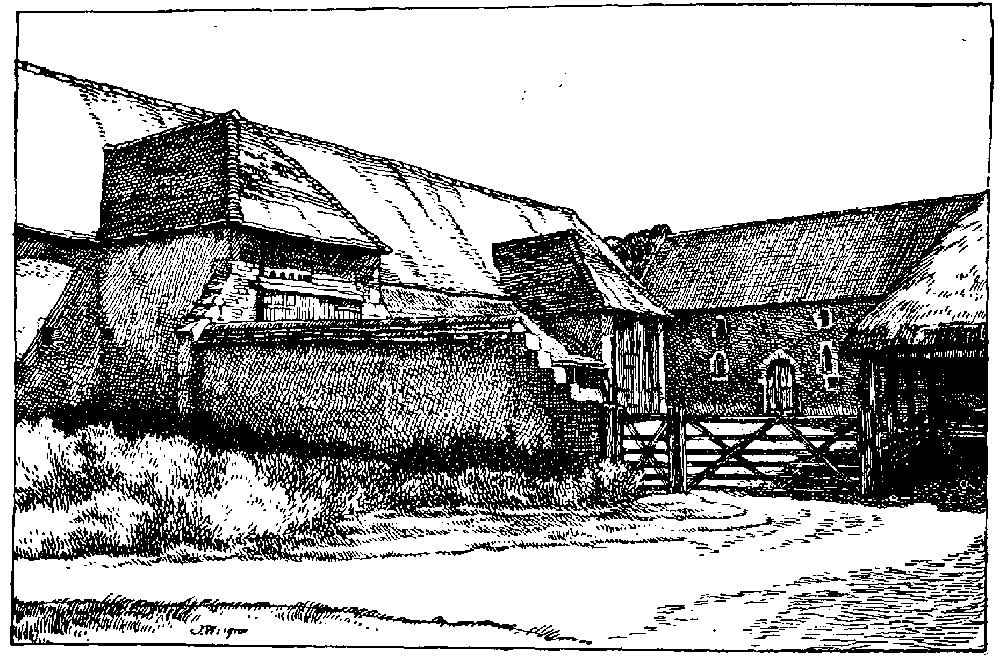
Rockbourne: Ancient Barn and Chapel
Manor
ROCKBOURNE was always a royal manor, and as such was neither assessed in hides nor paid geld. (fn. 5) At the same time Alwi son of Torber held a hide there, which Ulviet had held of King Edward, (fn. 6) and Sawin held half a hide of the gift of King Edward, to which the sheriff in 1086 made unsuccessful claim as part of the king's farm, but which at a later date reverted to the Crown. (fn. 7) Alwi was succeeded here as in Hale and Tytherley (q.v.) by the Cardenvilles, and in the 13th century William Cardenville held a free tenement in Rockbourne. (fn. 8) Before 1156 the manor, worth £40 blanch and £2 by tale a year, had been granted to Manser Bisset, the king's sewer. (fn. 9)
He was succeeded before 1177 (fn. 10) by a son Henry, who was living in 1189, (fn. 11) and whose widow Iseuld (fn. 12) was holding Rockbourne early in the next century. (fn. 13) His eldest son William died without issue c. 1220, and was succeeded by his brother John, (fn. 14) who died in 1241, (fn. 15) leaving three daughters—Margery wife of Richard de Rivers, (fn. 16) Ela and Isabel. Rockbourne passed to Ela, who became the wife of John de Wotton. Their son John assumed his mother's surname and succeeded his father in the manor in 1300. (fn. 17) He died seven years later, leaving an infant son John, (fn. 18) who died unmarried in 1334, devising the manor to his sister Margaret, at that time the wife of Robert Martin, (fn. 19) on whom the manor was settled in 1338. (fn. 20) Early in 1336 Robert Martin complained that a certain John de Crucheston (Crux Easton) and others had abducted Margaret his wife and taken away his goods. (fn. 21) Not waiting for justice, he retaliated by breaking into the house of John de Crucheston and seizing his property. (fn. 22) Some years later he took Crucheston prisoner, torturing him 'with cords tied round his head and other torments, (fn. 23) and extorting £1,150 from his friends for his release.' (fn. 24) Robert Martin (fn. 25) died in 1355, (fn. 26) his wife surviving him until 1373, when the manor passed to her eldest son by her first husband, Sir Walter de Romsey, (fn. 27) who in March 1401–2 settled it (fn. 28) on himself and his wife Alice for life, with reversion in tail-male to their grandson Thomas son of Thomas de Romsey, and, if he died without issue male, to his brother Walter. (fn. 29) Sir Walter died in 1403 (fn. 30) and Alice his widow in 1404. Thomas, their grandson and heir, (fn. 31) died in 1420–1, leaving an infant daughter Joan. (fn. 32) Rockbourne passed according to the above settlement to her uncle Walter, brother of Thomas, (fn. 33) but on the death of Walter son of Walter, in 1430, she inherited the manor and held it with her husband, Thomas Payne. (fn. 34) Her second cousin and one of her two heirs, Joan, formerly wife of Thomas Keilway (fn. 35) and then of Roger Wyke, daughter of Mary Byngham, daughter of the first Sir Walter Romsey, (fn. 36) inherited Rockbourne, which ultimately reverted to her descendants by her first husband. However, in the meanwhile it was claimed by Joan wife of Thomas Swete as next heir of Joan Payne, being, she stated, great-granddaughter of Margaret daughter of Sir Walter Romsey. Roger Wyke and his son John on behalf of the heirs of Joan his wife successfully denied the existence of Margaret and recovered the manor in 1462, (fn. 37) and although five years later Edward IV granted the manor in dower to Joan Swete, then a widow, (fn. 38) it was held by John Keilway, descendant of Joan Wyke, on his death in 1547. (fn. 39) His son William succeeded him, but after this date the history of the manor is uncertain. Some documents state that William Keilway during his lifetime gave the manor to his grandson Thomas, child of his son Francis, (fn. 40) and in 1577 a certain Richard Hunt declared he had seen the enrolment of this conveyance. (fn. 41) Certainly in 1580 and 1581 Thomas was dealing with the manor as his own, (fn. 42) but in 1570 Francis asserted that his father had in May 1565 settled the reversion on him in tail-male, (fn. 43) and he died seised of the manor in 1601–2. (fn. 44) This discrepancy may be accounted for by the relations between Francis Keilway and his son, (fn. 45) who in 1591 was imprisoned in the Fleet 'for procuringe and suborning certain persons to exhibit grevyous complaintes' against Anthony Ashley, clerk of the Privy Council, (fn. 46) and on obtaining his release in 1592 was found to have no money to pay the prison fees. (fn. 47) His father, with whom he had quarrelled, was ordered to provide for him as a ' gentleman pencioner,' (fn. 48) but in 1598 Thomas being ' utterlie lame and a creeple' complained that since his father had again cut off his allowance he was 'inforced to use very hard and base shiftes even for his foode and sustenance in such sorte as it is pitifull to make mencion.' (fn. 49) The Privy Council took the case in hand and ordered Francis to allow his son £3 weekly. (fn. 50) Refusing to obey, Francis for a long while ignored their letters, (fn. 51) but finally agreed to pay his son's debts and to allow him to 'lyve in house' with him. (fn. 52) Francis died in 1601–2 and Thomas succeeded (fn. 53) to Rockbourne, which, already heavily mortgaged to Sir Anthony Ashley, (fn. 54) he sold in 1608 to Sir Anthony's son-in-law, Sir John Cooper. (fn. 55) No sooner had this sale been effected than it was found that Francis had in 1574 settled the contingent remainder of the manor after himself and his heirs male on his brothers Ambrose and Edward, and that the latter ' of an ill intent' to prevent the sale of the manor had granted his interest in it to Queen Elizabeth in 1594. (fn. 56) James I, however,'not myndinge to favour such fraudulent conveyances,' gave up all 'remainder and interest' in the same in 1608. (fn. 57) Sir John Cooper was succeeded by his eldest son Anthony Ashley Cooper, created Earl of Shaftesbury in 1672, (fn. 58) and the manor has descended with the title to Sir Anthony Ashley Cooper, the ninth and present Earl of Shaftesbury.
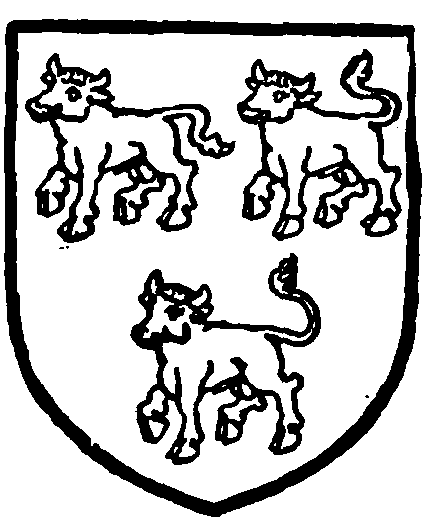
Ashley. Argent three bulls passant sable.

Cooper. Gules a bend engrailed between six lions or.
Parks
There were two parks in Rockbourne in 1307 containing 100 acres of large oaks and underwood worth 13s. 4d. yearly. (fn. 59) In the early 14th century, when, during the minority of John Bisset, the Bishop of Bath and Wells had the manor in custody, he complained that his park had been broken into, his deer hunted and his rabbits taken with 'ferrets' nets and other engines.' (fn. 60) In the reign of Edward VI East Park still belonged to the lord of the manor, who brought two suits for poaching against his tenants of Rockbourne. (fn. 61) In 1628 the other—West Park—belonged to Sir George Marshall and others, who in that year were paid £250 for keeping the king's race-horses in West Park and Cole Park. (fn. 62) It was purchased in 1762 by Sir Eyre Coote, the famous Indian General, and passed like South Damerham (q.v.) to the present Sir Eyre Coote. (fn. 63)
ROCKSTEAD (Rochesire, xi cent.; Rokkeseye, xiv cent.; Rocksted or Rocksythe, xvi cent.), which Aldwin held before the Conquest, belonged to Hugh de Port in 1086, (fn. 64) and to the St. John barony as late as 1349. (fn. 65) Probably the Testa de Nevill 'Fokeseya,' held by William de la Falaise of Robert de St. John, (fn. 66) is a mistake for Rokeseya, which was thus apparently granted to the priory of Breamore by some member of the Falaise family. Whoever the donor, Rockstead had passed to Breamore Priory before 1291. (fn. 67) It belonged to the priory at the Dissolution and was granted with its other possessions to Henry Marquess of Exeter and Gertrude his wife in November 1536. (fn. 68) Escheating to the Crown on the attainder of the marquess in 1539, it was granted to Anne of Cleves, (fn. 69) but in 1548 passed to Sir Thomas Henneage and William Lord Willoughby, (fn. 70) who in the following year sold it to William Keilway. (fn. 71) After this date it followed the descent of Rockbourne (fn. 72) (q.v.) and became merged in that manor, its name only surviving in Rockstead Farm.
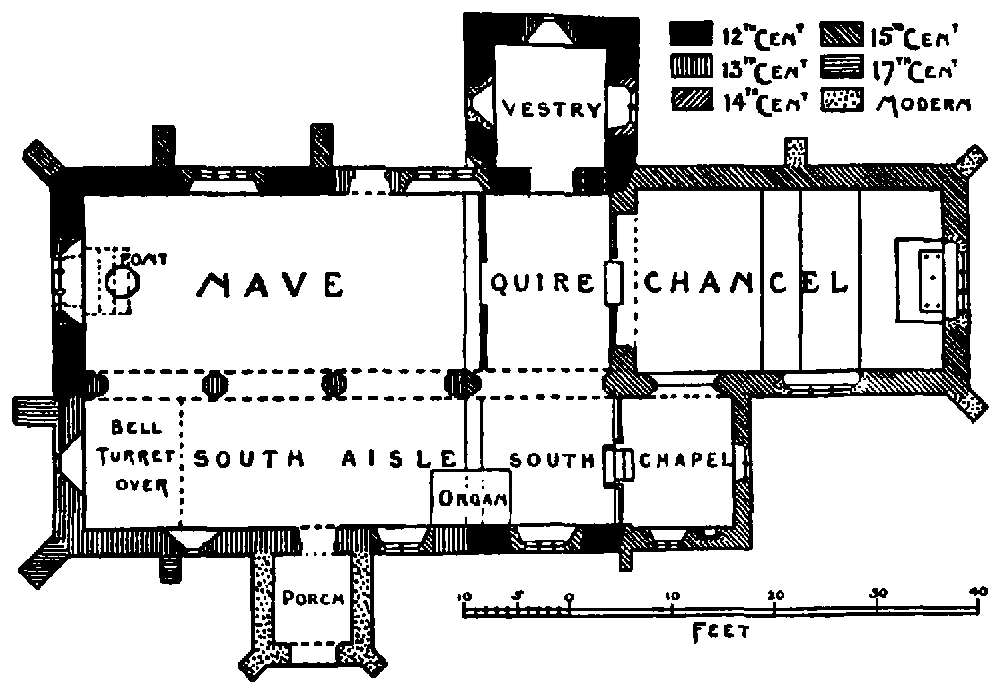
Plan of Rockbourne Church
Church
The church of ST. ANDREW consists of a chancel with south-west chapel, nave, north transept, south aisle, bellturret over west end of the aisle and south porch.
The earliest building for which architectural evidence exists consisted of an aisleless cruciform 12th-century church, the nave being of the same plan as at present, but with a smaller chancel. In the 13th century the south aisle was added and in the 15th century the chancel was rebuilt and enlarged, the chancel arch inserted, the south transept thrown into the south aisle, and a small chapel added to the east of it with an arch opening into the chancel. The south porch dates from 1893, the church having been restored in that year. The site falls steeply westwards, and the interior of the church is very picturesque from the number of steps to the chancel and altar. The wood fittings are also very well arranged, with low screens at the top of the steps to the chancel, south chapel, and the quire, which takes up the east bay of the nave. Parts of the woodwork are of 18th-century date, of good and simple patterns, and the rest is copied from them. At the west end of the south aisle is a painted board of the royal arms, dated 1678.
The east window of the chancel is modern, of five lights, with tracery of 15th-century style. In the south wall is a modern three-light window of the same character, but the north wall has no openings and is covered with white marble monuments of the Coote family. A four-centred arch of two continuous chamfered orders opens to the south chapel. The chancel arch is also four-centred with two chamfered orders dying into the jambs. The only remaining piece of 12th-century detail is the narrow, round-headed arch of one square order, with chamfered abaci, which leads into the north transept, its voussoirs being alternately of green and white stone. The transept has evidently been a good deal patched, but seems to preserve its original plan. The east window is of two trefoiled lights under a square head, probably late 14th-century work, and the wall over it has been patched with red tiles set in herring-bone pattern.
In the north wall is a wide splayed lancet with external rebate, much modernized, but probably of 14th-century date originally, and in the west wall is a similar window which appears to be modern.
West of the transept a wide 15th-century window of three trefoiled lights has been inserted, the transept wall being cut away to allow the window to be set as far to the east as possible. A second window of the same type occurs to the west of the north door, which has a cinquefoiled head of 13th-century date corresponding to one in the farm buildings below the church. The south arcade is of four bays, the eastern bay being of 15th-century date, distinct from the others, and with a wide four-centred arch and plainly moulded capitals. The three western bays are 13th-century work, probably c. 1230, and have octagonal piers, moulded capitals and bases, and arches of two chamfered orders, built in green sandstone. One of the capitals is, however, cut from a block of ironstone. In the west wall of the nave are the lower courses of the jambs of a late 12th-century doorway, from which a flight of steps led up to the level of the nave floor. Its head has been destroyed by the insertion of a window above, which in its turn has been much altered and raised and now has modern three-light tracery in the jambs and an arch of re-used 13th-century detail. Below its present sill are three blocked lights continuing the lines of the window, and the font is now set at the west end of the nave in the space formerly occupied by the steps leading up from the old west door.
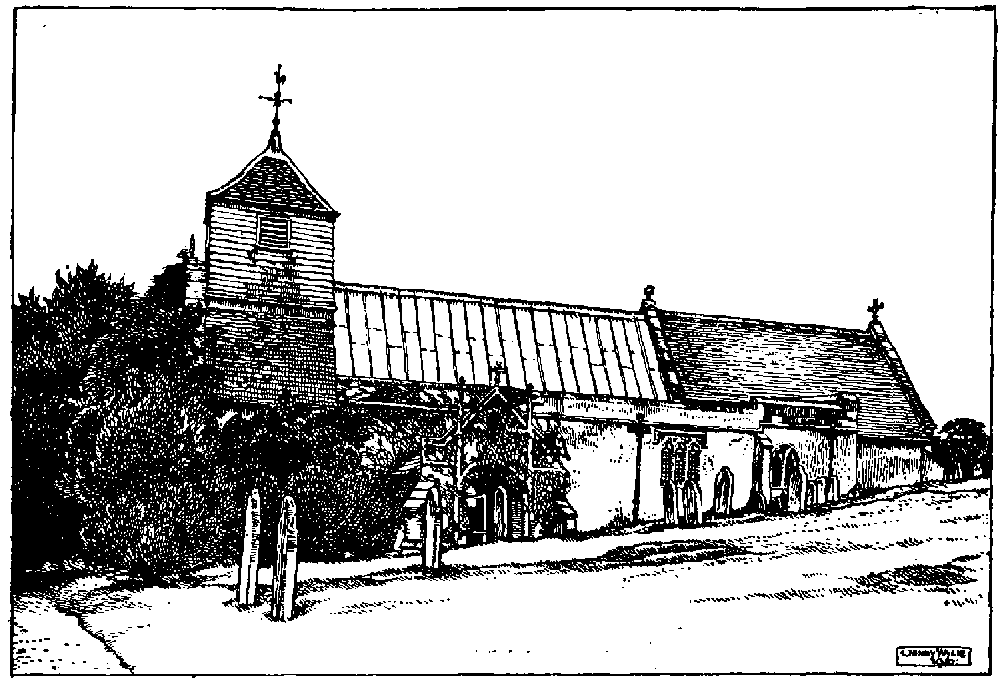
Rockbourne Church from the South
The south chapel has a 15th-century east window of two trefoiled lights with a quatrefoil in the head. In the south wall is a pointed piscina recess with hollow-chamfered jambs and head, apparently 14th-century work re-used. It has a stone shelf. West of it is a window of two trefoiled lights under a rounded head, the tracery being probably also 14th-century work, reset at a considerably later date. In the south aisle are 13th-century lancets at the west and south-west, the latter modern externally, and two 15th-century windows, the earlier of which is of three trefoiled lights under a square head, retaining three fragments of original glass, one bearing the Maria monogram in gold and white glass.
In the other window, which has two cinquefoiled lights with a quatrefoil in the head, is the head of our Lord in similar glass. The south doorway is plain 13th-century work with two continuous chamfered orders and pointed head, the outer vertical boarding of an old door being fixed to a modern frame. Inside the door to the east is the head of a holy water recess. The chancel roof is modern, of the same type as that of the nave, which is probably of 16th-century date, though much repaired. It has a plastered wagon-headed ceiling panelled with moulded ribs having carved bosses at the intersections. The plates are moulded, with an embattled cresting which is nearly all modern, and two modern tie-beams have been inserted.
The aisle roof is nearly flat and has moulded principals and rafters. The transept roof is old with trussed rafters, and in the transept, which is used as a vestry, is a good 17th-century altar table. The upper entrance to the rood-loft remains at the southwest of the nave, and the east splay of the north-east nave window is cut back for the fitting of a parclose screen. The font is octagonal, probably dating from the 15 th century, and has a modern base.
The tower contains three bells and a ' ting-tang.'
The last is inscribed in Roman capitals: 'ward seymovr sq of woodled' 'in the covnty of dors 1718 wt.' The treble is inscribed 'In God Triomp I W 1617,' and the second 'O prayes the Lord I W 1617.' The third was recast by Mears & Stainbank in 1893. The treble and second are by John Wallis of Salisbury.
The plate consists of a silver chalice of 1692 and a paten of 1861.
The registers are contained in six books. The first, which is a parchment transcript of 1601, contains baptisms and burials from 1561 to 1652 and marriages from 1561 to 1647. The second and third have all entries from 1653 to 1672, and from 1673 to 1713 respectively. The fourth has all entries from 1714 to 1778, with a gap between 1747 and 1770 and only a few entries from 1771 to 1778. The fifth has marriages only from 1778 to 1812, and the sixth baptisms and burials from 1779 to 1812. There are also churchwardens' and overseers' accounts.
Advowson
In the 12th century Manser Bisset granted the church of Rockbourne to the Prior of Maiden Bradley (fn. 73) (co. Wilts.), who made an agreement with the Prior and canons of Breamore, by which the latter were to hold the advowson of Rockbourne for the yearly payment of 100s. to Maiden Bradley. (fn. 74)
Henry de Blois, Bishop of Winchester (1129–71), with the assent of Manser Bisset, confirmed the appropriation of the church to Breamore, and assigned a pension of 2s. to Crispin the priest. (fn. 75) The church belonged to Breamore at the time of the Dissolution, and followed practically the same descent as the advowson of Breamore (fn. 76) (q.v.) until both were sold to Henry Longden in 1777. (fn. 77) Rockbourne was purchased in 1822 (fn. 78) by the trustees of Rev. W. J. Yonge, who three years later sold it to Sir (then Mr.) Eyre Coote of West Park. (fn. 79) It continued in his family until 29 September 1881, when it was sold to the present owner, Mr. A. N. Radcliffe, and Mr. Robert Vernon Somers-Smith. (fn. 80)
The rectorial tithe followed the same descent as the advowson until 1685, in which year Anne Lady Brooke settled it in trust for the rectors of the parish. (fn. 81)
Charities
In 1824 the Rev. Henry Longden, by his will proved in the P.C.C., devised land for the instruction of six poor girls in singing the psalms in church, such donation to be inscribed on a tablet in the church. The devise was inoperative as being void in mortmain.
The Yonge Charity, founded by the Misses Yonge by deed of 25 March 1899, is regulated by a scheme of the Charity Commissioners of 9 June 1903. The endowment consists of £166 13s. 4d. Natal 3 per cent. Stock with the official trustees, the dividends to be applied for the benefit of poor deserving persons in money gifts and in coals.